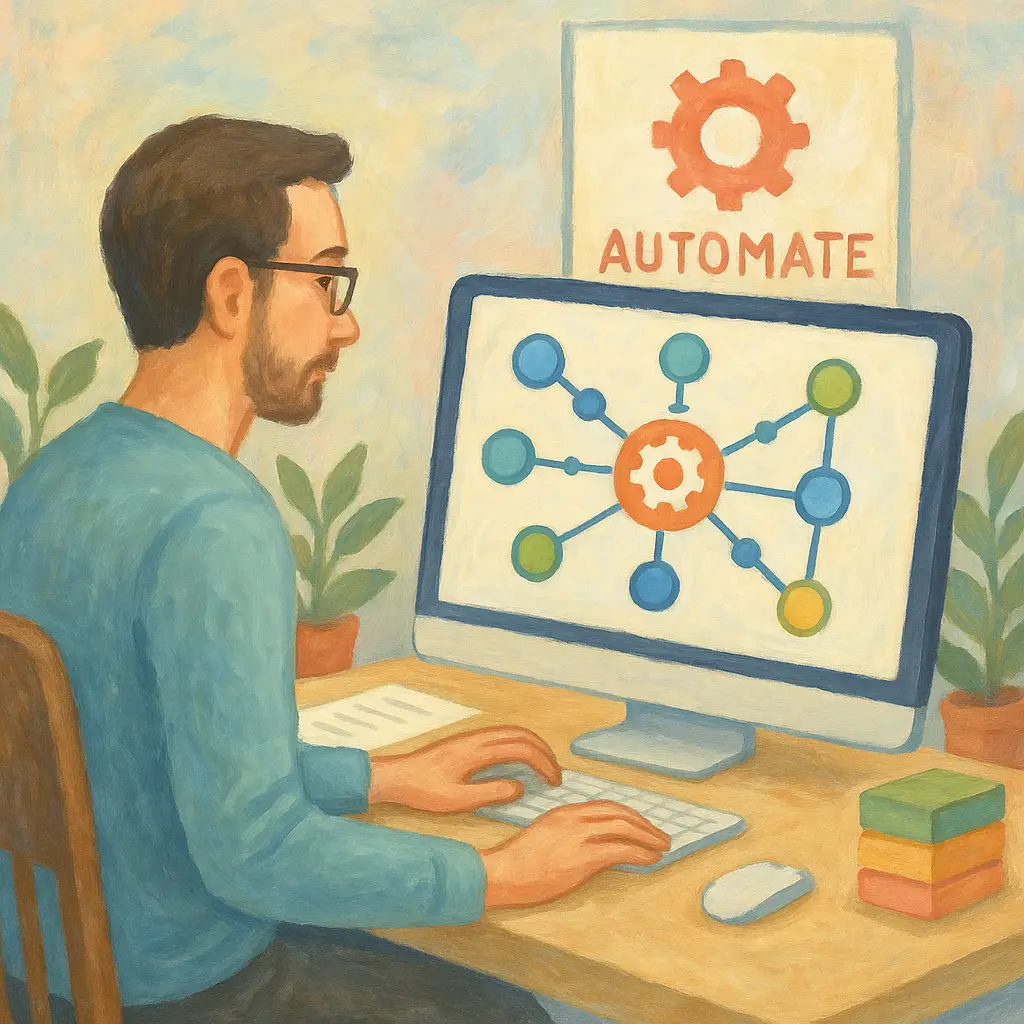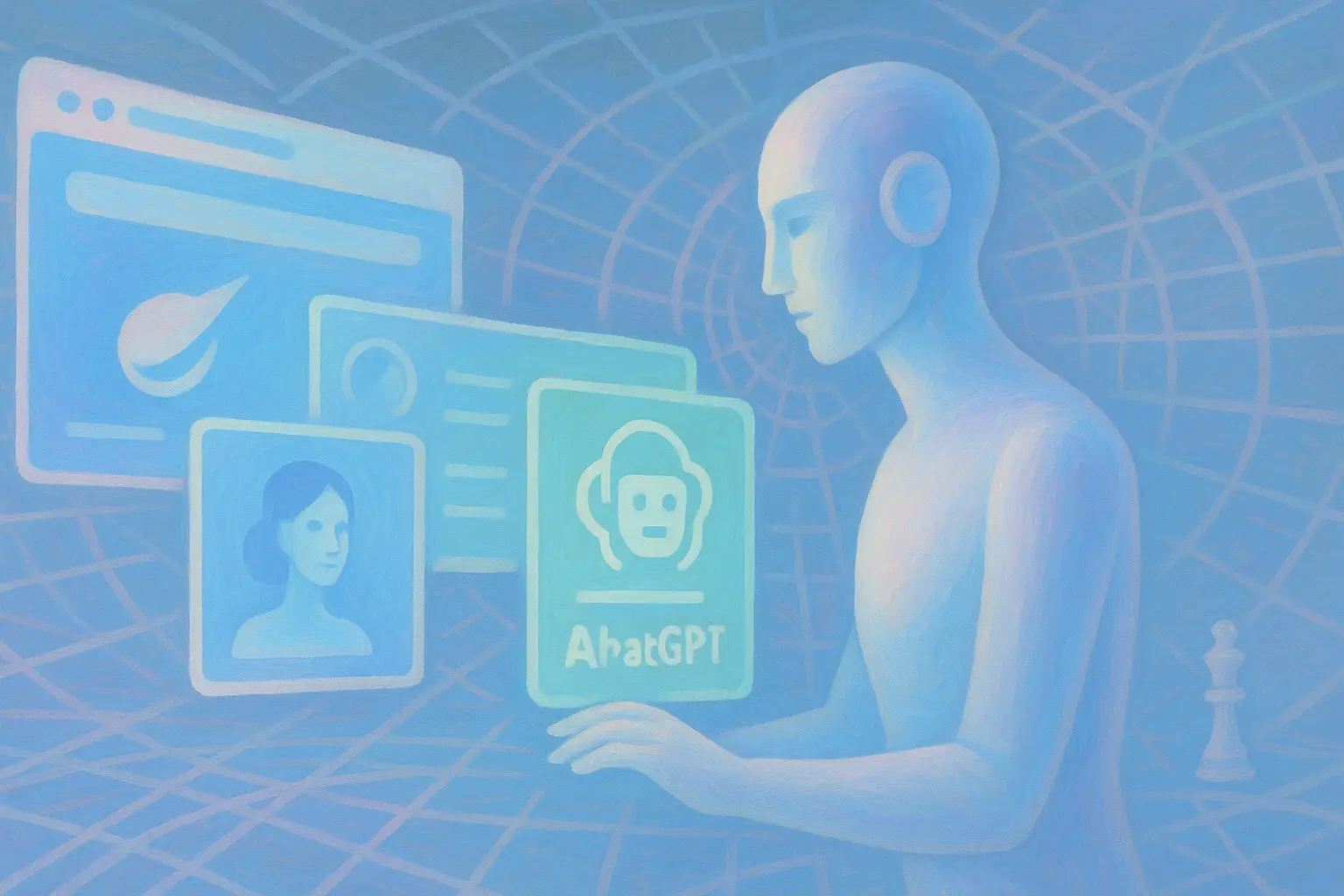
Automation Tasks & Job Titles: n8n Guide
Table of Contents
- Introduction
- Understanding Task Automation
- Overview of n8n and Its Competitors
- How Automation Transforms Job Titles and Roles
- Real-World Applications and Workflows
- Best Practices and Tips for Automation
- Conclusion
- Frequently Asked Questions (FAQs)
Introduction
In today's fast-paced digital environment, the demand for automation has skyrocketed. Whether it's simplifying repetitive tasks or redefining job roles, automation tools are changing the way we work. One tool that has steadily gained popularity is n8n—a versatile platform that allows both no-code and code-based workflow automation. But n8n is far from the only player in this rapidly expanding field. Other tools such as Make, UiPath, and Automation Anywhere are also making waves by offering tailored solutions to different automation needs.
This article will explore the automation of tasks and even the transformation of job titles using n8n and similar tools. We will discuss how these platforms simplify complex workflows, illustrate effective use cases, and highlight best practices for deploying automation. Whether you work in IT, marketing, operations, or any other field, this guide will help you understand how to harness automation for improved efficiency and innovation.
Automate with n8n
Build workflows that save time and scale your work. Start free. Grow as you go.
Start Free with n8nUnderstanding Task Automation
Task automation is the process of using software tools and technologies to execute repetitive and rule-based tasks without manual intervention. By automating mundane processes, organizations can reduce human error, free up time for strategic activities, and ensure consistency in operations. Here are some of the fundamental aspects of task automation:
- Consistency and Accuracy: Automated workflows ensure that each task is performed uniformly every time, reducing the risk of human error.
- Efficiency: Automation cuts down the time required to complete routine tasks, allowing employees to focus on more creative and high-value projects.
- Scalability: As businesses grow, the manual execution of tasks becomes unsustainable. Automation provides a scalable solution that adapts to increasing workload without a proportional increase in effort.
- Cost Savings: By reducing the dependency on manual labor for repetitive tasks, companies can achieve significant cost savings over time.
Key Areas Where Automation Excels
- Data Processing and Entry: Tasks like data entry, data extraction, parsing, and form filling are streamlined through automation.
- Customer Relationship Management (CRM): Automated workflows can update databases, send follow-up emails, and manage lead tracking efficiently.
- Marketing Campaigns: Automation can be used for drip campaigns, social media posts, and targeted email marketing—all coordinated seamlessly.
- IT and Systems Management: Routine IT processes such as backups, updates, monitoring, and troubleshooting can be automated to ensure system reliability.
- Human Resources: Automated candidate screening, resume parsing, and interview scheduling help streamline recruitment processes.
Overview of n8n and Its Competitors
What is n8n?
n8n is a free, open-source platform that allows users to automate their workflows using a simple drag-and-drop interface, as well as through code for more complex situations. What makes n8n particularly compelling is its hybrid nature: it offers both no-code and code-based approaches. This flexibility makes it accessible to both beginners and experienced developers.
Key Features of n8n:
- Visual Workflow Builder: Create workflows using an intuitive interface that simplifies automation design.
- Integration with LLMs: n8n can link up with any Large Language Model (LLM), paving the way for advanced AI-driven tasks.
- Self-Hosting Option: For organizations concerned about data privacy, n8n offers easy self-hosting.
- Robust Community: With an active open-source community, you can find plenty of templates and integration examples.
For more details, visit n8n's official website.
Similar Tools to Consider
While n8n is a robust option for many, several other platforms offer unique strengths. Here’s a quick glance at some leading competitors:
| Tool | Key Features | Ideal For |
|---|---|---|
| Make | Visual no-code interface, easy AI integration | Non-technical users, small to medium teams |
| UiPath | Agentic automation, pre-built AI models, enterprise-grade | Large enterprises and complex workflows |
| Automation Anywhere | Generative AI capabilities, enhanced process automation | Organizations needing creative AI tasks |
- Make (Formerly Integromat): Renowned for its visual approach, Make offers extensive integrations with over 2000 applications. It simplifies the process with a completely no-code interface while also integrating AI tools for data analysis and content automation.
- UiPath: A leader in robotic process automation (RPA), UiPath is known for its powerful enterprise features including pre-built AI models and strong governance protocols that are ideal for large companies.
- Automation Anywhere: Focuses on combining traditional RPA with generative AI elements. It is well-suited for businesses that require AI-driven content creation alongside robust automation capabilities.
How Automation Transforms Job Titles and Roles
As automation evolves, it does not merely reduce workload—it also redefines job descriptions. Automation changes what it means to have roles in modern organizations. Let’s delve into some of the ways tasks and job titles are being transformed:
New Job Titles in the Era of Automation
-
Workflow Automation Engineer:
- Focus: Designing and maintaining automated workflows.
- Responsibilities: Developing, testing, and refining automation processes using tools like n8n and UiPath.
-
AI Integration Specialist:
- Focus: Leveraging AI tools (including LLMs) to enhance workflow automation.
- Responsibilities: Integrating AI functions such as natural language processing into automation pipelines.
-
Digital Transformation Consultant:
- Focus: Helping organizations transition towards digital and automated systems.
- Responsibilities: Advising companies on technologies and strategies to improve operational efficiency through automation.
-
RPA Developer:
- Focus: Building, deploying, and managing robotic process automation solutions.
- Responsibilities: Crafting scripts and tools that automate repetitive tasks across various systems.
How Job Roles are Changing
- Enhanced Strategic Focus: Automation liberates employees from mundane tasks, allowing them more time for strategic decision-making and creative problem-solving.
- Cross-Functional Expertise: Many roles now require an understanding of both the technical aspects of automation tools and the business processes they affect.
- Upskilling and Reskilling: Companies invest in training current employees to work with automation tools, fostering a culture of continuous learning and innovation.
- New Opportunities: The rise of automation has led to the creation of entirely new roles and career paths that did not exist a few years ago.
A modern professional might find themselves juggling responsibilities that include overseeing automated systems while also ensuring that those systems align with broader business objectives. This shift not only saves time and resources but also enhances job satisfaction by reducing the tedium of repetitive tasks.
Real-World Applications and Workflows
To understand the practical impact of automation, it is useful to look at real-world applications and how tools like n8n enable dynamic workflows. Here are several detailed examples:
Case Study 1: Marketing Automation
Imagine a marketing team that needs to run a global campaign where emails, social media posts, and advertisement updates must be processed seamlessly. An automated workflow would include:
-
Email Campaigns:
- Trigger: New product launch information is added to a database.
- Action: Automatically generate personalized emails using an AI model to customize content based on customer preferences.
- Follow-Up: Scheduled reminders and feedback collection.
-
Social Media Integration:
- Trigger: Data from a trending news source is captured.
- Action: Generate social media posts, analyze sentiment, and schedule posts across multiple platforms.
-
Ad Performance Monitoring:
- Trigger: Advertisement performance metrics are updated in real-time.
- Action: Automatically adjust ad budgets, update content, or trigger alerts for manual review if needed.
Using n8n, the team can design a workflow that integrates with tools like Google Analytics, Mailchimp, and social media platforms. The visual drag-and-drop interface and the ability to inject custom code for specific actions simplify the entire process.
Case Study 2: Customer Support Automation
Customer support teams often handle routine inquiries that can be automated. Consider the following workflow:
-
Chatbot Integration:
- Trigger: A customer inquiry is received via a messaging platform.
- Action: The chatbot processes the query using an AI model to understand the issue and provide an instant response.
-
Ticket Management:
- Trigger: If the chatbot cannot resolve the issue, it automatically creates a support ticket in a CRM system.
- Action: The ticket is tagged based on the query type and assigned to the appropriate support representative.
-
Feedback Loop:
- Trigger: After the support interaction, an automated survey is sent to the customer.
- Action: Responses are analyzed for sentiment and used to update the FAQ database or trigger escalations in case of negative feedback.
For organizations using n8n, integrating with platforms such as Slack, Zendesk, or even custom-built systems becomes straightforward. Each step can involve conditional triggers, ensuring that the workflow is responsive and adaptive to individual customer needs.
Detailed Workflow Example using n8n
Below is a simplified diagram of an n8n workflow for handling job application processes:
- Trigger: A new job application is received via email.
- Data Extraction:
- The email content is parsed using an integrated LLM.
- Relevant fields like applicant name, contact information, and job title are extracted.
- Candidate Screening:
- The extracted data is compared against predefined criteria.
- AI functions rank applicants based on their match to the job description.
- Automated Follow-Up:
- Successful candidates receive an auto-generated confirmation email.
- Unsuccessful candidates are sent a polite declination email with feedback.
- Integration with HR Systems:
- The candidate’s data is stored in an HR management system.
- Notifications are sent to the HR team for further action.
This workflow not only speeds up the hiring process but also minimizes manual errors. For more detailed examples, you can check out n8n documentation and explore community-shared workflows on n8n GitHub.
Visual Representation
Here's an illustrative table summarizing the automated process for job application screening:
| Step | Trigger/Action | Tools Involved |
|---|---|---|
| Application Received | Email trigger | Email platform, n8n trigger node |
| Data Extraction | Parse email content using LLM | n8n, AI integration |
| Candidate Screening | Evaluate application against criteria | Custom code, logic nodes in n8n |
| Automated Follow-Up | Send emails based on screening outcome | Email node in n8n, integrated actions |
| HR System Integration | Record candidate data and notify HR team | n8n API node, HR system integration |
Using such tables and lists clarifies each step in the automation process and helps teams understand the interdependencies and integration points.
Best Practices and Tips for Automation
No matter which tool you choose, there are several best practices to ensure that your automation efforts are successful and sustainable.
1. Start with a Clear Objective
- Clearly define the task you want to automate.
- Identify the repetitive steps that consume the most time.
- Establish measurable goals to evaluate automation success.
2. Map Out Your Workflow
- Sketch a flowchart of your process before implementation.
- Consider all possible scenarios and exceptions.
- Use tools like Lucidchart for detailed visualization.
3. Leverage Community Templates and Resources
- Begin with pre-built workflows available in the n8n community.
- Explore templates available on the n8n website and adapt them to suit your needs.
- Engage with communities on forums and GitHub to share best practices.
4. Mix No-Code and Code-Based Approaches
- Start with a no-code design to outline the automated process.
- Enhance with custom code where flexibility and advanced logic are needed.
- Maintain readability and documentation for future developers.
5. Ensure Robust Error Handling
- Incorporate error node functionalities in your workflow.
- Set up alert systems to notify responsible team members when an error occurs.
- Regularly review logs and performance data to fine-tune processes.
6. Regularly Update and Optimize
- Automation is not a one-time project. Regular updates are crucial.
- Periodically audit your workflows to identify bottlenecks.
- Use metrics and analytics to continually optimize for efficiency.
How to Get Started with n8n
For those interested in diving into automation with n8n, here is a step-by-step guide:
-
Installation:
- Choose between self-hosting or using a cloud-based service.
- Follow the installation guide available on n8n's docs.
-
Basic Workflow Creation:
- Start with a simple workflow (e.g., an email trigger and a response action).
- Explore the intuitive drag-and-drop interface to add nodes step by step.
-
Integrate AI and Data Processing:
- Learn how to integrate Large Language Models (LLMs) to add AI capabilities.
- Experiment with data parsing nodes to automate information extraction.
-
Explore Advanced Features:
- Customize workflows with JavaScript or Python where necessary.
- Use conditional logic and error handling nodes to manage exceptions.
- Leverage community examples and templates for inspiration.
-
Test and Launch:
- Test the workflow thoroughly to ensure it performs as expected.
- Launch it into production and monitor performance using built-in logging and dashboards.
Conclusion
Automation is no longer a futuristic concept—it is the backbone of modern organizational efficiency. Tools like n8n empower teams to design tailored workflows that not only save time and costs but also transform how job roles are executed. Whether it's simplifying routine data entry, revolutionizing the recruitment process, or enabling real-time customer support, automation is reshaping the workplace landscape.
Using n8n along with other similar tools creates opportunities to redefine job roles—from workflow automation engineers to AI integration specialists—making work more dynamic and strategic. The blend of no-code simplicity and code-based flexibility provides the ideal environment where businesses of all sizes can innovate and thrive. By embracing automation, companies can unlock new levels of productivity and empower their workforce to focus on what truly matters: creativity, strategy, and growth.
For those on the cusp of digital transformation, remember that the journey starts small. Embrace the power of automation one workflow at a time, leveraging best practices, continuous improvement, and a community of experts. As technology evolves, so will the opportunities—allowing you to stay ahead in the race toward operational excellence.
By following the guidelines laid out in this article and leveraging automation tools such as n8n, you can fundamentally transform both your daily tasks and your organization’s job roles. The future of work is all about working smarter, not harder—and automation is the key to unlocking that potential.
Frequently Asked Questions
Share this article
Related Articles

ChatGPT Go Free in India: Unlock AI Power 2025!
Explore how OpenAI's ChatGPT Go free offer in India is set to transform AI accessibility, from enhanced features to market impact and strategic benefits.

Atlas vs Comet: AI Browser Battle 2025
Dive deep into the world of AI-native browsers with ChatGPT Atlas and Perplexity Comet. Explore their unique features, philosophies, and the battle that is reshaping how we interact with the web.

ChatGPT Atlas: AI Browser Revolution
Explore how ChatGPT Atlas, OpenAI's groundbreaking AI-powered browser, transforms web browsing with contextual intelligence, personalized automation, and robust privacy controls.
